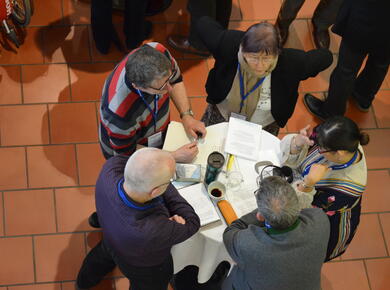Posted: September 3, 2020
It had been more than 15 years since we last lived in Zagreb, now the capital of Croatia, when we returned for a brief visit in 2006. Sitting at a sidewalk cafe on a sunny Saturday morning, my wife Sara and I spotted posters around town that would surely not have been allowed during our earlier times in former Yugoslavia when communists held sway: “March for Jesus!” Scanning the info, I could not discern which denomination might be sponsoring the event. Curious, we next discovered the procession itself, wending a joyful way through the city centre over to what locals call Cvjetni trg (“flower square”).
Still puzzling about what kind of people could pull together such a public demonstration of faith, we were suddenly hailed by one of the organizers, who exclaimed with delight: “This started in your living room!”
Stanko had been one of several young Pentecostal church leaders who gathered monthly with us during 1988 and 1989 for prayer across the denominational barriers that ordinarily kept folks in their separate flocks. Baptist, Pentecostal, Brethren and several other independent-minded branches of the small neo-Protestant movement welcomed the opportunity to confer, pray and build bonds of friendship during the harsh times that plunged the region into chaos and war as the 1990s unfolded.
Long after we had returned to North America, these promising ties had grown into cooperation for many aspects of witness, war relief and outreach to neighbours, in faith.
In the darkest hours of the Wars in the Balkans (1991–95, and beyond), faith-based peacemaking efforts drew deeply from the wells of ecumenical and even inter-faith cooperation. In Bosnia, Serbia and Croatia, followers of Jesus felt called to cross boundaries, build bridges, practice forgiveness and extend basic human hospitality to persons in extreme danger from horrific violations on all sides.
Some MWC readers will know of the witness of Hleb Života (Bread of Life humanitarian organization) in Belgrade, or Pontanima (inter-faith choir) in Sarajevo. These and many other efforts have made a lasting contribution to peacebuilding in the wake of human-made catastrophes in the region.
Because of my extensive involvement with Pentecostal Christians in the Balkans, it has been my privilege in more recent years to participate in official denominational dialogues between Mennonite Church USA and some parts of the wider Pentecostal movement.
The Church of God (based in Cleveland, Tennessee, USA) has been a partner for several rounds of theological discussions on the presence and power of the Holy Spirit, in worship and outreach and mission. Many participants voiced keen interest in Anabaptist experiences where Jesus’ followers, in the power of God’s Spirit, act as agents of reconciliation and peace in current human conflicts.
God is still forging new things among us as the Spirit continues breaking down walls of hostility and sending us forth as ambassadors with the power of Christ’s love.
Toward that end, I am inspired by Shane Claiborne, Christian activist in Philadelphia (Pennsylvania, USA), who urges us to learn from the best of what many diverse Christian traditions have to offer each other:
“Just as we critique the worst of the church, we should also celebrate her at her best,” Shane Claiborne writes in the journal Oneing. “We need to mine the fields of church history and find the treasures, the gems…. I want the fire of the Pentecostals, the love of Scripture of the Lutherans, the political imagination of the Anabaptists, the roots of the Orthodox, the mystery of the Catholics, and the zeal of the Evangelicals.”
I’m convinced that we are all much more a mixture of these many strands than we usually admit. We all drink from streams that include ancient Orthodox Christian worship formulations, deeply Catholic reflective traditions, robust Lutheran convictions, classic Reformed doctrines, and warmly Pietist practices – along with some forms of Anabaptist commitments and beliefs that the earliest generations might or might not recognize as akin to their own.
We hybridize and select and respond to new situations while drawing from diverse source materials. Taken altogether, these colorful threads become our own new fabric, a tapestry that belongs to our own time and is meant as a gift to our contemporaries.
Side by side, the mighty river of Pentecostals today and the heirs of the Anabaptist stream of the Christian tradition may seem fairly remote from each other, but the underground reality is more closely connected than one would first detect. Where we find ourselves working together, there is a hope that the forces of prophetic zeal, impassioned witness and basic compassion can revitalize the paths of Spirit-empowered discipleship in a complex world.
—Gerald Shenk taught in seminaries in Croatia, Serbia, and the USA (Virginia and Indiana), before taking up grandpa duties with a small farm in Virginia. He is a member of Springdale Mennonite Church.
This article first appeared in Courier/Correo/Courrier April 2020. Click here to read other articles from this issue.

Comments: